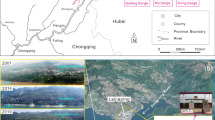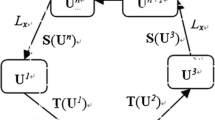Abstract
Flow-like landslide is one of the most catastrophic types of natural hazards due to its high velocity and long travel distance. In 2019, a large catastrophic landslide was triggered by heavy rainfall and occurred in Shuicheng County, Guizhou, China. The Shuicheng landslide was characterized by a short slip time, high speed, and long sliding distance, causing significant damages to the downstream communities and properties. Depth-averaged models have been widely used to predict the velocity and runout distance of flow-like landslides. However, most of the existing depth-averaged models have various shortcomings for application in real-world simulations. In this study, a high-performance depth-averaged model taking into account the effects of topography-related vertical acceleration and centrifugal force was used to examine the influence of complex 3-D terrain on the landslide movement process. The simulation results were in satisfactory agreement with the field observations. This work reveals the landslide movement process at different stages, including acceleration, diversion, secondary acceleration, impact, and deposition. The maximum average velocity was predicted to be 35 m/s, with a local maximum velocity exceeding 50 m/s. The seismic records obtained from the adjacent seismic stations and the predicted kinetic energy and velocity of the landslide event revealed a dual acceleration and obstruction process. It was also found that the movement process and final deposit morphology were strongly influenced by the complex terrain and were sensitive to the surface friction coefficient. This may also be the reason for the survival of some houses in the middle of the slope during the event. This study provides a reference for investigating long-runout, high-speed, flow-like landslides.
















Similar content being viewed by others
References
Bouchut F, Westdickenberg M (2004) Gravity driven shallow water models for arbitrary topography. Commun Math Sci 2(3):359–389 https://projecteuclid.org/euclid.cms/1109868726
Castro-Orgaz O, Hutter K, Giraldez JV et al (2014) Nonhydrostatic granular flow over 3-D terrain: New Boussinesq-type gravity waves. J Geophys Res Earth Surf 120:1–28. https://doi.org/10.1002/2014JF003279
Denlinger RP, Iverson RM (2004) Granular avalanches across irregular three-dimensional terrain: 1. Theory and computation. J Geophys Res 109 (F1):F01014. https://doi.org/10.1029/2003JF000085
Ekstrom G, Stark C (2013) Simple scaling of catastrophic landslide dynamics. Science 339:1416–1419. https://doi.org/10.1126/science.1232887
Fan XM, Xu Q, Scaringi G, Dai L, Li W, Dong X, Zhu X, Pei X, Dai K, Havenith HB (2017) Failure mechanism and kinematics of the deadly June 24th 2017 Xinmo landslide, Maoxian, Sichuan, China. Landslides 14:2129–2146. https://doi.org/10.1007/s10346-017-0907-7
George DL, Iverson RM (2014) A depth-averaged debris-flow model that includes the effects of evolving dilatancy. II. Numerical predictions and experimental tests. Proc R Soc A Math Phys Eng Sci 470(20130820). https://doi.org/10.1098/rspa.2013.0819
Gray JMNT, Edwards AN (2014) A depth-averaged μ(I)-rheology for shallow granular free-surface flows. J Fluid Mech 755:503–534. https://doi.org/10.1017/jfm.2014.450
Gray JMNT, Wieland M, Hutter K (1999) Gravity-driven free surface flow of granular avalanches over complex basal topography. Proc R Soc A Math Phys Eng Sci 455:1841–1874. https://doi.org/10.1098/rspa.1999.0383
Guizhou Meteorological Bureau (2019) Liupanshui: check the past meteorological data of the landslide site, and the chief forecasters of the municipal meteorological bureau study the future weather trend together. https://gz.cma.gov.cn/xwzx/qxyw/201907/t20190725_939861.html. Accessed 25 July 2009 (in Chinese)
Guo J, Yi S, Yin Y, Cui Y, Qin M, Li T, Wang C (2020) The effect of topography on landslide kinematics: a case study of the Jichang town landslide in Guizhou, China. Landslides 17:959–973. https://doi.org/10.1007/s10346-019-01339-9
Guthrie RH, Friele P, Allstadt K, Roberts N, Evans SG, Delaney KB, Roche D, Clague JJ, Jakob M (2012) The 6 August 2010 Mount Meager rock slide-debris flow, Coast Mountains, British Columbia: characteristics, dynamics, and implications for hazard and risk assessment. Nat Hazards Earth Syst Sci 12:1277–1294. https://doi.org/10.5194/nhess-12-1277-2012
Hergarten S, Robl J (2015) Modelling rapid mass movements using the shallow water equations in Cartesian coordinates. Nat Hazards Earth Syst Sci 15(3):671–685. https://doi.org/10.5194/nhess-15-671-2015
Hu K, Wu C, Tang J, Pasuto A, Li Y, Yan S (2018) New understandings of the June 24th 2017 Xinmo landslide, Maoxian, Sichuan, China. Landslides 15:2465–2474. https://doi.org/10.1007/s10346-018-1073-2
Hungr O, Leroueil S, Picarelli L (2014) The Varnes classification of landslide types, an update. Landslides 11:167–194. https://doi.org/10.1007/s10346-013-0436-y
Iverson RM, George DL (2014) A depth-averaged debris-flow model that includes the effects of evolving dilatancy. I. Physical basis. Proc R Soc A Math Phys Eng Sci 470(20130819). https://doi.org/10.1098/rspa.2013.0819
Iverson RM, George DL, Allstadt K, Reid ME, Collins BD, Vallance JW, Schilling SP, Godt JW, Cannon CM, Magirl CS, Baum RL, Coe JA, Schulz WH, Bower JB (2015) Landslide mobility and hazards: implications of the 2014 Oso disaster. Earth Planet Sci Lett 412:197–208. https://doi.org/10.1016/j.epsl.2014.12.020
Juez C, Murillo J, García-Navarro P (2013) 2D simulation of granular flow over irregular steep slopes using global and local coordinates. J Comput Phys 255:166–204. https://doi.org/10.1016/j.jcp.2013.08.002
Legros F (2002) The mobility of long-runout landslides. Eng Geol 63(3–4):301–331. https://doi.org/10.1016/S0013-7952(01)00090-4
Mangeney A, Bouchut F, Thomas N, Vilotte JP, Bristeau MO (2007) Numerical modeling of self-channeling granular flows and of their levee-channel deposits. J Geophys Res Earth Surf 112:1–21. https://doi.org/10.1029/2006JF000469
Pouliquen O, Forterre Y (2002) Friction law for dense granular flows: application to the motion of a mass down a rough inclined plane 453:133-151. https://doi.org/10.1017/S0022112001006796
Pudasaini SP, Hutter K (2003) Rapid shear flows of dry granular masses down curved and twisted channels. J Fluid Mech 495:193–208. https://doi.org/10.1017/S0022112003006141
Pudasaini SP, Hutter K, Hsiau SS, Tai SC, Wang Y, Katzenbach R (2007) Rapid flow of dry granular materials down inclined chutes impinging on rigid walls. Phys Fluids 19(5):053302. https://doi.org/10.1063/1.2726885
Savage SB, Hutter K (1989) The motion of a finite mass of granular material down a rough incline. J Fluid Mech 199:177–215. https://doi.org/10.1017/S0022112089000340
Scheidegger AE (1973) On the prediction of the reach and velocity of catastrophic landslides. Rock Mech Rock Eng 5:11–40. https://doi.org/10.1007/BF01301796
Watkins JA, Ehlmann BL, Yin A (2015) Long-runout landslides and the long-lasting effects of early water activity on Mars. Geology 43(2):107–110. https://doi.org/10.1130/G36215.1
Xia X, Liang QH (2018) A new depth-averaged model for flow-like landslides over complex terrains with curvatures and steep slopes. Eng Geol 234:174–191. https://doi.org/10.1016/j.enggeo.2018.01.011
Xia X, Liang Q, Ming X (2019) A full-scale fluvial flood modelling framework based on a high-performance integrated hydrodynamic modelling system (HiPIMS). Adv Water Resour 132:103392
Yin Y, Xing A (2012) Aerodynamic modeling of the Yigong gigantic rock slide-debris avalanche, Tibet, China. Bull Eng Geol Environ 71(1):149–160. https://doi.org/10.1007/s10064-011-0348-9
Zhang Z, He S, Liu W et al (2019) Source characteristics and dynamics of the October 2018 Baige landslide revealed by broadband seismograms. Landslides 16:777–785. https://doi.org/10.1007/s10346-019-01145-3
Zhao W, Wang R, Liu X, Ju N, Xie M (2020) Field survey of a catastrophic high-speed long-runout landslide in Jichang Town, Shuicheng County, Guizhou, China, on July 23, 2019. Landslides 17:1415–1427. https://doi.org/10.1007/s10346-020-01380-z
Zhou J, Cui P, Hao M (2016) Comprehensive analyses of the initiation and entrainment processes of the 2000 Yigong catastrophic landslide in Tibet, China. Landslides 13:39–54. https://doi.org/10.1007/s10346-014-0553-2
Funding
This study was financially supported by the Foundation of the State Key Laboratory of Geohazard Prevention and Geoenvironment Protection (Grant No. SKLGP2018Z014), the Foundation for Innovative Research Groups of the National Natural Science Foundation of China (Grant No. 41521002), the National Natural Science Foundation of China (Grant No. 41907250), and the National Key Research and Development Project (Grant No. 2019YFC1509602).
Author information
Authors and Affiliations
Corresponding author
Rights and permissions
About this article
Cite this article
Zhao, W., Xia, X., Su, X. et al. Movement process analysis of the high-speed long-runout Shuicheng landslide over 3-D complex terrain using a depth-averaged numerical model. Landslides 18, 3213–3226 (2021). https://doi.org/10.1007/s10346-021-01695-5
Received:
Accepted:
Published:
Issue Date:
DOI: https://doi.org/10.1007/s10346-021-01695-5




